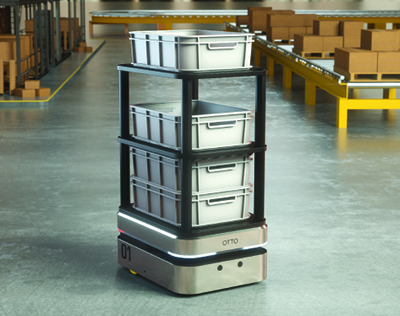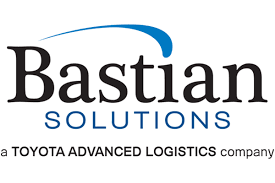It’s time to begin automating your warehouse to keep pace with business. Either through growth in e-commerce or a restructuring of the distribution center network, many warehouses that used to do fine with mostly manual methods need automation to adapt to new requirements.
That decision process for automation used to center on an analysis of historical demand patterns. But what happens when e-commerce sends assumptions around order mix and volume out the window?
The answer, say providers of warehouse automation, is that the reasons why you automate begin to change. It’s less about raw efficiency in processing large batches of work and more about speed and flexibility in getting e-commerce orders out the door.
“In the not too distant past, you could take order line data, analyze it, apply some growth projections, and say, ‘this is the volume and mix the warehouse will need to be processing over the next few years,’ and you could build and automate a warehouse,” says A.K. Schultz, vice president of retail and e-commerce markets for Swisslog, a provider of warehouse automation. “The problem is, you can’t do that now, especially in retail, where because of e-commerce volatility, retailers really don’t know what is going to happen.”
As a result, says Schultz, retailers tend to look for DC automation that is quicker to install, easier to reconfigure, and can scale to demand. “In the e-commerce world, more and more of our customers are uncertain about what the future holds, so suddenly flexibility becomes way more important,” he says.
What exactly does a more flexible approach to automation mean? It can mean leveraging mobile robots to transport goods, including “goods-to-person” solutions. Automation providers also say that other technologies should make it easier to quickly stand up systems, such as augmented reality (AR) glasses, while the warehouse execution system (WES) software layer will be important to blending in the new technologies. It’s all part of the trend toward making automation—whether newer technologies or more traditional systems—more adaptable.
Robots on the rise
Most automation vendors, even those who offer fixed systems, agree that mobile robots can be a flexible way to handle goods without much infrastructure. Small robotic vehicles can support zone picking with totes or bring rolling carts laden with goods to light-driven picking workstations. Some vendors have also outfitted mobile robots with picking arms or other attachments that allow them to perform picking or other tasks.
What’s more, the mobile robots of today use advanced navigation technologies that allow them to operate with zero or minimal guidance infrastructure, which adds to their flexibility compared to the automatic guided vehicles (AGVs) of the past. AGV vendors also offer smaller, “smart AGVs” that, like mobile robots, need minimal or no guidance infrastructure.
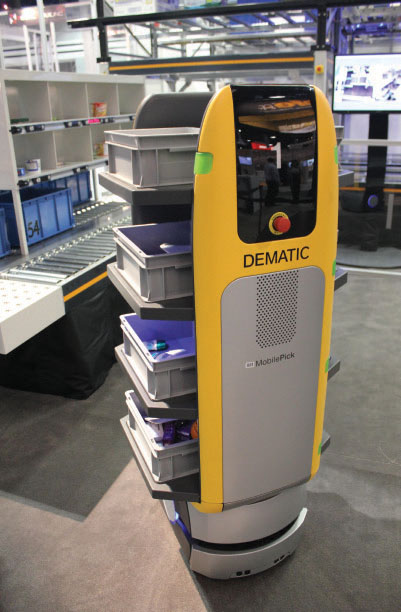 “Perhaps the biggest change in the market is the move to navigation that allows the vehicles to operate without anything on the floor or reflectors on racks or columns,” says Sarah Carlson, vice president of AutoGuide, a mobile robotics vendor. “Not needing special guidance infrastructure is appealing because there is nothing extra to install, and over time, it makes for a system that is very flexible.”
“Perhaps the biggest change in the market is the move to navigation that allows the vehicles to operate without anything on the floor or reflectors on racks or columns,” says Sarah Carlson, vice president of AutoGuide, a mobile robotics vendor. “Not needing special guidance infrastructure is appealing because there is nothing extra to install, and over time, it makes for a system that is very flexible.”
Mobile robots may need a short session to “learn” the layout a facility, but then new workflows can be easily configured in the software, or with some solutions, by running a vehicle through a new route. “The newer forms of navigation match up well with the market need, which is all about constant change and keeping pace in a way that is simpler and less expensive,” says Carlson.
Analyst firm Tractica predicts that the robotics market in warehousing and logistics will explode over the next few years, expanding from $1.9 billion in 2016 to $22.4 billion in value by the end of 2021. Their analysis looks at robotics broadly, including mobile robots, robotic shuttle systems, industrial robotic arms and gantry robots.
Mobile robots take on sortation
Mobile robotics are beginning to be applied to other tasks besides goods transport. Providers such as IAM Robotics offer mobile robots that can do piece picking, and now Tompkins International is leveraging mobile robots for sortation.
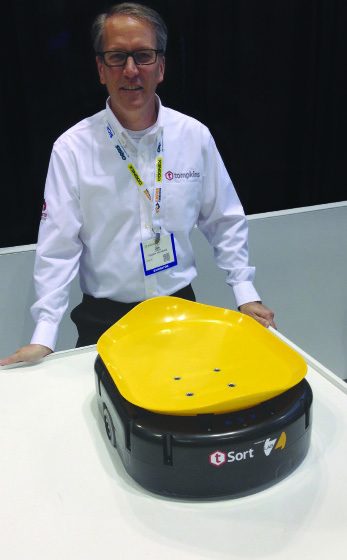 Under an offering it calls Tompkins Robotics, Tompkins has partnered with a robotics company to devise a unit and parcel sortation system called t-Sort that carries out the same functions as a tilt tray sorter on a fixed track, but with no track and using less space, says Jim Serstad, a managing director with Tompkins. Instead of a large track and chutes that deploy to the sides, the t-Sort uses independent, small mobile robots that each have a tray on top and move on a raised platform that has multiple chute openings with pack stations located underneath.
Under an offering it calls Tompkins Robotics, Tompkins has partnered with a robotics company to devise a unit and parcel sortation system called t-Sort that carries out the same functions as a tilt tray sorter on a fixed track, but with no track and using less space, says Jim Serstad, a managing director with Tompkins. Instead of a large track and chutes that deploy to the sides, the t-Sort uses independent, small mobile robots that each have a tray on top and move on a raised platform that has multiple chute openings with pack stations located underneath.
“What we’ve done is taken the same application handled by a conventional tilt tray sortation system that on runs on a track and decoupled it from the track,” says Serstad. “The system’s robots will take the shortest route from the induction point to the chutes for fast throughput, and because it’s on a raised platform with pack stations directly underneath the chutes, that reduces the floor area needed. So the system offers high throughput, uses less floor space, and comes in at a significantly lower capital cost than a traditional system. It’s about two-thirds the capital cost of a conventional system.”
The t-Sort has its own control system to manage the paths for the robots and ensure collision avoidance. When used for unit sortation, it is paired with Tompkins’ warehouse execution system software to dynamically allocate orders to chutes and orchestrate with other warehouse processes, says Serstad. A typical t-Sort system might have 300 chutes and 350 robots, which allow it to sort 18,000 units per hour.
Flexibility is the biggest advantage of sortation based on mobile robots, according to Serstad. During peak season, a system’s capacity can be increased by adding more robots, while to keep pace with longer term growth, additional platform space, induction points, chutes and pack stations can be added without shutting down the existing system. “The big advantage is flexibility,” Serstad. “It’s a fairly lightweight platform that can be added to pretty easily, or during peak times, you can just add additional robots to gain more capacity.”
The robot-based sortation system is quick to implement, says Serstad, with a system deployable in as little as six months. The relatively quick deployment time helps organizations that are under pressure to deploy new systems, says Serstad, while the smaller physical footprint of the raised platform should suit metro DCs where space costs are high. “Cost per square foot is a big factor for many fulfillment centers,” he says. “If you can save 30% to 40% on floor space versus a traditional system, that reduces costs, especially for those fulfillment centers servicing densely populated urban areas.”
The top target market segment for the robotic sortation system are parcel carrier facilities, but also retail industry DCs or other with e-commerce operations, says Serstad. The current robot can sort/handle goods weighing up to about 11 pounds, but a future robot option will be able to sort goods weighing up to about 50 pounds.
Robotic arms have evolved in recent years, says Schultz, to encompass a new class of smaller arms with sensing technology that allows them to work side by side with humans in item picking, rather than caged off like bigger robotic arms used in some DCs for pallet building. When outfitted with a gripper attachment that can handle a mix of small items, these “collaborative robots,” says Schultz, offer flexibility in that an operation’s capacity can be scaled up by adding either more human pickers or more “co-bots.”
Similarly, mobile robotics can scale just by adding more vehicles. To scale a robotics goods-to-person system, says Schultz, it’s just a matter of adding more robots or rolling shelves/carts. Additionally, with mobile robotics, the system can continue to function even as components are added.
“With our mobile robotics, once you put in the software and some base infrastructure, you can scale up quickly by adding more components as volumes increase,” Schultz says. “Ultimately, you are able to scale your system in small steps without long lead times for deployment.”
Another advantage of adopting mobile robots is there will be less fixed infrastructure to impede the movement of human operators around put walls or other pick-to-light (PTL) workstations, notes Jim Bast, vice president and general manager of Matthews Automation’s Lightning Pick brand, which offers order picking solutions. “We see much of the advantage from mobile robots as coming from the flexibility of movement it allows for human operators,” says Bast. “When you start adding lots of automation to a DC, it can start looking like an expressway interchange in Southern California.”
Fixed but modular
While “fixed” automation like conveyor systems are seen as less flexible to change, flexibility is a relative thing. “Before flexible and scalable become an industry norm, we’d been using it as a mantra within Dematic for years,” says Mike Khodl, vice president of solution development for Dematic, a warehouse automation vendor. “We support that by engineering systems that are flexible to your business, scalable to growth and modular in design. The modularity allows us to go faster on the implementation side, and reconfigure a system or move it without massive costs.”
With a Dematic modular conveyor, explains Khodl, “modules” or segments that address different functions fit easily into the support structure and power and wiring connectors. “If you had a long run of accumulation conveyor, and you wanted to add a new function to it, with our modular conveyor, we can simply take out a couple of dozen rollers, add an induct belt and divert, changing the flow of that system,” says Khodl. “To make a change like that with a modular design, you don’t have to rerun wiring, or redo the metal framing, you just drop in the new module.”
Dematic also offers mobile robots, says Khodl, and recognizes the flexibility they offer. Khodl says mobile robots like Dematic’s MobilePick units can be a good, scalable alternative to using totes and conveyor for moving goods between zones.
Khodl doesn’t see mobile robots taking over warehouse automation. Fixed automation such as shuttle systems remain a dense, high-speed way to buffer and hold goods, he says, so it’s possible warehouses will use a shuttle system to replenish and hold goods that feed a zone picking process using mobile robots. “As we progress over the next several years, I think warehouses will use a mix of automation technologies and humans to achieve efficient order fulfillment and flex to demand requirements,” he says.
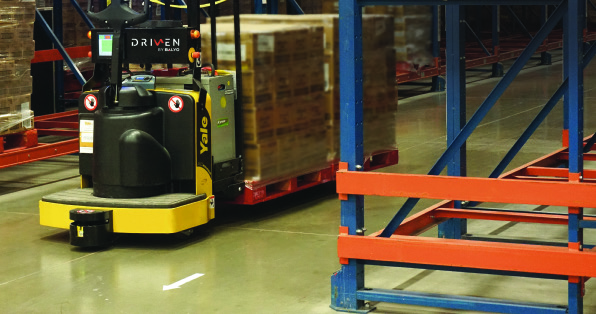
Despite the volatile nature of e-commerce, it’s still advisable to assess the peaks and valleys of a DC’s demand profile to see where robotics might fit in, says Eric Cameron, vice president of software sales for Bastian Solutions. The danger about getting too excited about robots, he adds, is that they are no more of a silver bullet than other solutions like put walls.
“Put walls are great, but maybe the problem is that a put wall fed by traditional RF picking isn’t going to be fast enough, but if you integrate some type of goods-to-person robotics to feed the put wall, then it can be compelling,” says Cameron.
Software as key
The key to getting various automation resources working in concert will be software, Khodl says. The best positioned suppliers, he adds, will be able to offer WES software that ensures a productive flow of work between all types of automation and human labor.
“It’s all about the software,” says Khodl. “How well you can manage orders, allocate resources, and optimize individual processes around order fulfillment is key to making that DC do what it needs to do,” Khodl says. “To be both efficient and flexible, you’ve got to have a configurable software package at the warehouse execution level that you can assign business rules to.”
Software for mobile robots functions at two levels. The first is fleet management to set up the vehicles, configure routes and track performance. A robotics system also will typically work with a WES that will pass order fulfillment requirements to it and coordinate material flow.
Simon Drexler, director of industrial solutions with OTTO Motors, a division of Clearpath that offers mobile robots, says its fleet management software can interface with various other systems, including WES. The fleet management software for a robotics solution should be easy to use, says Drexler. “A system like OTTO is a point-and-click user interface, so you can easily make updates as frequently as you need,” he says. “So, as your operation evolves, as product lines change or demand fluctuates through seasonality, you can update delivery points or routes in seconds.”
While software helps with the flexibility of a robotics solution, Drexler advises that the navigation technology used also is essential for speed of set-up. The best systems, he adds, use multiple technologies to see and understand the layout of a facility, functioning much like a person’s eyes and brain would in learning how to navigate an unfamiliar building. Clearpath calls the technology its robots use to “learn” a new facility simultaneous localization and mapping, or SLAM, says Drexler. The resulting “spatial representation” the robots acquire about a DC helps deployment speed and adds to the base flexibility of adding more vehicles, he says.
AR as accelerator
Augmented reality (AR) glasses are another promising technology for making warehouse automation more agile. In particular, Microsoft’s HoloLens AR glasses—which allow a view of the physical reality, but can mix that view with holographic information—are seen as a promising means of mimicking hard-wired, pick-to-light solutions.
Matthews Automation has been developing with HoloLens to achieve a virtual PTL capability, says Bast, using the glasses at a demo at the ProMat 2017 show. Currently, Bast adds, the glasses aren’t rugged enough for warehouse use, “but we believe that as these [AR glasses] solutions become more industrialized, and frankly, more cost effective, there may come a time when maybe there won’t be physical lights needed for applications like put walls.”
Bastian is another vendor testing HoloLens for virtual PTL. Bastian’s Cameron says AR glasses could also prove valuable for helping human operators build better mixed pallets. Cameron agrees that HoloLens, while powerful in terms of the holographs it can display, isn’t yet rugged enough for warehouse use. “Our work with AR right now is to make sure that the technology on the hardware side is suitable for use in our industry, we are going to be ready to utilize to its fullest,” he says.
Other warehouse automation vendors are using AR glasses to help design and visualize how a materials handling system will function, so another use for AR in warehousing will be in speeding up the design of fixed automation systems. That seems a fitting application, given that the business drivers are increasingly about standing up systems more quickly, and making them more adaptable to fast-paced business needs.
Companies mentioned in this article:
- AutoGuide
- Bastian Solutions
- Clearpath Robotics/OTTO Motors
- Dematic
- Matthews Automation/Lightning Pick
- Swisslog WDS
- Tompkins
About the Author
Follow Robotics 24/7 on Linkedin
About the Author
Follow Robotics 24/7 on Linkedin
Article topics
Email Sign Up

